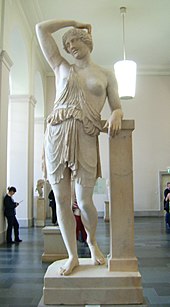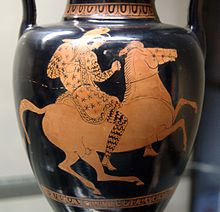Amazons
![]()
This article is about the mythical people - for other meanings, see Amazon (disambiguation).
Amazons (ancient Greek Ἀμαζόνες Amazónes) are the names given in Greek myths and legends to some peoples where women went into battle "equal to men". Ancient authors locate Amazons in various regions on the Black Sea: in or north of the Caucasus region, but especially in the northern Anatolian part of the Pontos region, where their capital Themiskyra (on the Thermodon) is said to have been located. Amazons are also said to have lived in Caria and Lycia as well as in Libya. There are reports about Amazon queens and city founders. Amazons are always described as normal mortals; often they are defeated in battles, in some places their burial places are mentioned.
Numerous works of Greek art depict Amazons as daring female fighters and mounted warriors, preferably on vases from about 550 BC onwards. In the 4th century B.C. representations of the "Amazon fight" (Amazonomachy) were popular. Two weapons are peculiar to the representations of Amazons from the last third of the 5th century B.C. onwards: the labrys, a double axe also called Amazon axe, and the pelte, a small, crescent-shaped shield. Their typical clothing consists of a short chiton, which often leaves the right breast uncovered.

Amazone type Sciarra, Collection of Classical Antiquities Berlin
Origin of the name
Since ancient times, the derivation of the name has been disputed and remains unexplained to this day. A number of ancient authors traced the Greek name "Amazon" to a-mazos (ἀμαζός "breastless"). For the Amazons are said to have mutilated the right breast of their little daughters so that they could later shoot the bow without hindrance. However, in the Greek representations Amazons were usually depicted with two breasts and according to Philostratus they were only not suckled at the breast.
Other explanations derived the name from a-maza (ἀμᾶζα "breadless"). To this fits the remark of Aeschylus, who calls them kreoboros (κρεοβόρος "fed with meat") in his Protective Pleas.
Also a derivation from zone (ζώνη "belt" from ζώννυμι "to gird") was thought. Ama-zone thus meant something like "well girded" and would have alluded to the costume of the Amazons, as also reflected in the myth of the robbery of Hippolyte's girdle by Heracles. A composition of hama and zosai (ἅμα ζῶσαι) in the sense of "living together" was also considered.
Archaeological finds
Georgia
In 1927, the grave of a 30 to 40 year old woman was discovered in Semo-Avchala, near Tbilisi in Georgia. Among other grave goods, a bronze sword, an iron spearhead and the remains of a horse's head were found. Since the skull of the deceased showed traces of a severe cut or stab wound (which the woman had apparently survived at first), it is assumed that the grave belonged to a warrior who possibly also fought on horseback. The grave is dated to the beginning of the 1st millennium BC and would thus be the oldest known grave of a female warrior. As the place of discovery south of the Caucasus is only a few hundred kilometres away from the alleged heartland of the Amazons of the Greek myths, there might be a connection with them.
Southern Russia and Ukraine
It is thought possible that the real models for the Amazons among the Greeks were tribes of the Scythians and Sarmatians.
Anthropologist David W. Anthony wrote in 2007 that about 20 percent of the Scythian or Sarmatian "warrior graves" on the lower Don and lower Volga contained female skeletons whose clothing corresponded to that of male warriors.
The Russian archaeologist Leonid Jablonskij and the US archaeologist Jeannine Davis-Kimball were able to prove that between the 6th and 3rd century BC there were peoples in southern Russia, Ukraine and Kazakhstan where women occupied a high social position and fought with weapons. They found numerous kurgans of Scythian and Sarmatian women buried with weapons and armor in southern Russia and Ukraine. One important site is a necropolis at Pokrovka, located southwest of Sol-Ilezk on the Ilek River. Between about 600 and 300 BC, more weapon grave goods were added to the female graves here than to the male ones. In the last third of the occupation phase the burial city was used by Sarmatians. Some of the weapons show signs of use, so they were probably used. It is probable that the necropolis in Pokrovka is the burial site of the Sauromatians mentioned by Herodotus.
In other graves 2500 year old female skeletons were discovered, which were anatomically striking. Their femurs were bent and their coccyxes were compressed, so they had probably ridden a lot when they were young; however, war injuries were not proven on the skeletons. Weapons were found among the grave goods. One grave contained not only jewelry, such as dozens of gold beads, gold brooches, and an earring, but also more than 110 arrowheads; the quantity of arrowheads leads researchers to believe that the dead woman was a mounted warrior.
Davis-Kimball connects the Amazons as a motif in Greek vase painting from the 6th century B.C. on with the fact that the Greeks at that time learned about the Scythians and Sarmatians. Therefore the Amazons were depicted similar to the Scythians (or also Parthians), but therefore they must not be identical with them. It had been common in Greek art to represent ancient or mythical peoples as contemporary peoples from approximately the same region were dressed and armed.
Ethnological and genetic researches of Davis-Kimball have shown that the traces of the Amazons can possibly be traced back to Mongolia, where according to Davis-Kimball's researches there are supposed to be genetic descendants of the Sarmatians and Scythians.
.JPG)
Wounded Amazon , Roman copy after a Greek original from the 5th century BC.

Mounted Amazon in Scythian costume (red-figure vase painting, c. 420 BC)
Search within the encyclopedia